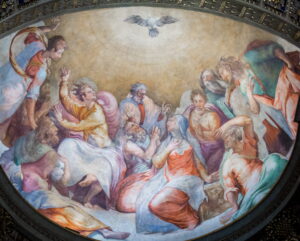
The Communion of Saints
The ACNA is a fairly small world, which means that many of you were shocked to hear the news that 50-year-old Fr. Thomas McKenzie and his 22-year-old daughter were killed in a car accident this past Monday. Fr. Thomas was the founding rector of Church of the Redeemer, an ACNA church in Nashville, and author of the well-beloved introduction to Anglicanism, The Anglican Way. As an aspirant to the priesthood in the ACNA, I am forever shaped by Fr. Thomas’s life and ministry, as are countless other priests, deacons, and laypeople in the ACNA and beyond.
One such priest is Tish Harrison Warren, whose training for Holy Orders took place under Fr. Thomas. In her book, Liturgy of the Ordinary, Tish wrote, “Thomas…often asked us to imagine the communion table stretching on for miles, to remind us that when we take Communion, we mysteriously feast with all those who are in Christ. In the Eucharist, we commune with Dorothy Day and Saint Augustine, the apostle Paul and Billy Graham, Flannery O’Connor and my own grandmother. One day we will all feast together, in the flesh, with Christ himself” (Warren, Liturgy of the Ordinary, 119).
This is not a fantastical image—it is Christian doctrine. If you pray the Daily Office, you declare belief in this doctrine each day when you recite the Apostles’ Creed: “I believe in the Holy Spirit, the holy catholic Church, the communion of saints, the forgiveness of sins, the resurrection of the body, and the life everlasting” (emphasis mine). From the earliest days of the Church’s history, Christians have professed faith in what Fr. Thomas described as a miles-long communion table. A fourth-century liturgy reads, “We present the offering to you for all the saints who have been pleasing to you from the beginning, patriarchs, prophets, the just men, apostles, martyrs, confessors, bishops, priests, deacons, subdeacons, readers, singers, virgins, widows, laypeople, and for all those whose name you know” (Apostolic Constitutions, 8.12.43-44).
Indeed, when we dine on Sunday morning, we dine at a table that stretches on for miles. We dine alongside one another, yes, but we also dine alongside the faithful departed who have fallen asleep. This is a profound mystery, of which Gregory the Great writes, “Can any of the faithful doubt that at the hour of the Eucharist…the choir of angels are present, the heights joined to the depths, earth linked with heaven, the visible united with the invisible” (Dialogue 4.60). At the Eucharistic table, we brush elbows with the living and the dead, taking spiritual food and drink with all of Christ’s beloved.
And on the last day, when the doors of Christ Church’s Columbarium swing open and death is swallowed up forever, we will dine then, too—in the company of all the saints. Saint Augustine. Gregory the Great. Fr. Thomas. But most importantly, we will dine with Jesus, whose power alone can bring about “the resurrection of the dead, and the life of the world to come.”
Grace and Peace,
Bree Snow
Minister of Formation and Catechesis

